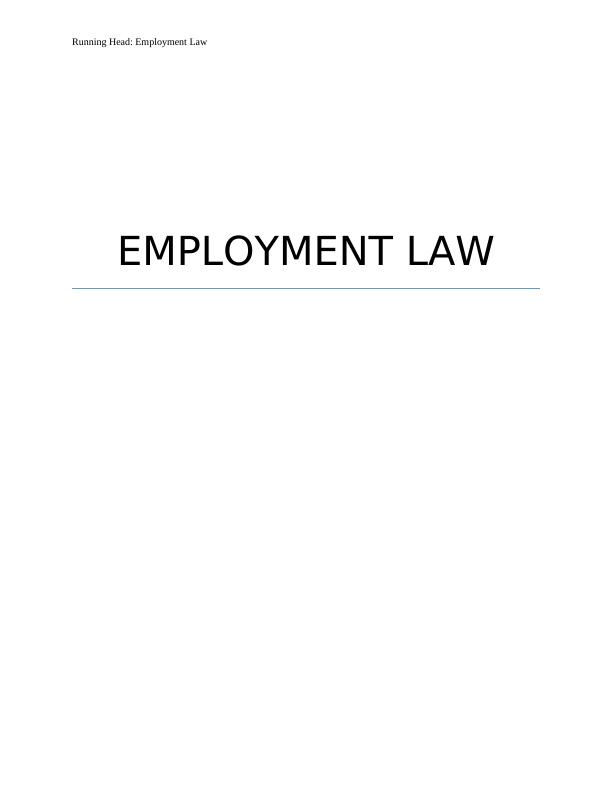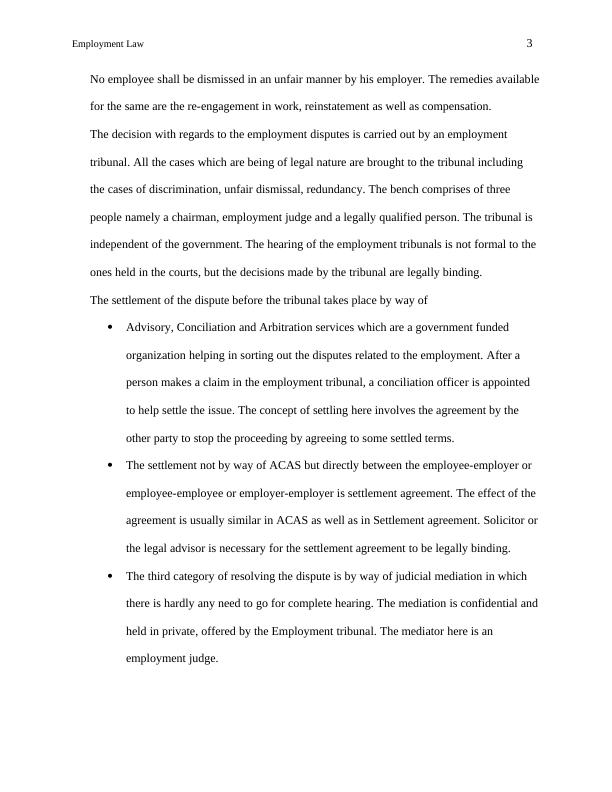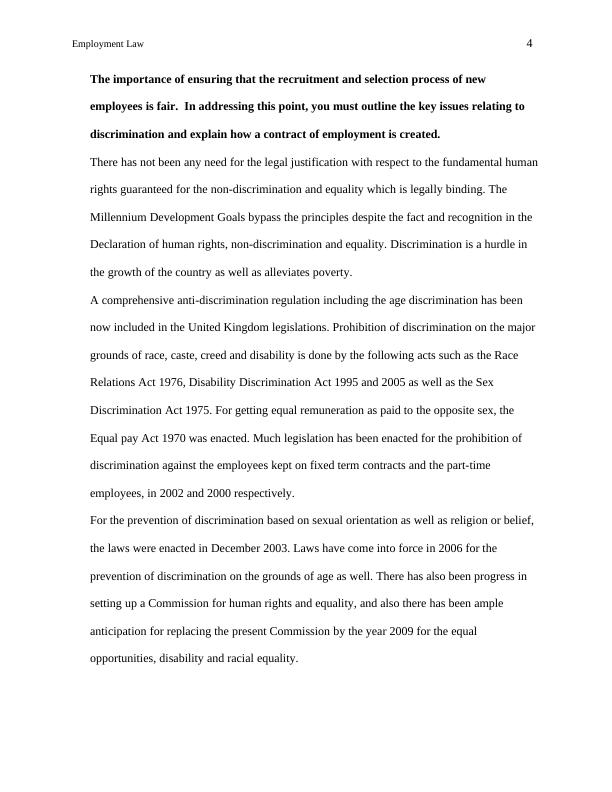Ask a question from expert
Aims and Objectives of Employment Law
13 Pages3415 Words1944 Views
Added on 2019-10-16
Aims and Objectives of Employment Law
Added on 2019-10-16
BookmarkShareRelated Documents
Running Head: Employment LawEMPLOYMENT LAW

Employment Law2EMPLOYMENT LAW1.Explain the aims and objectives of employment law. You must include the role of the Employment Tribunal and other courts in the UK in enforcing the law, and the ways of settling disputes before and during the Employment Tribunal process.There are many situations where the employees would be left hostile and treated unfairly at the workplace by the employers or other employees, and this takes place without a proper legislation or laws that govern the workplace environment. So many laws are put up for protecting as well as benefitting the employees and the employers from the harassment faced in a workplace. Hence, there evolved the concept of the rights of employment, race relation and sex discrimination in a workplace.The definition of employee as encapsulated under the Employment Rights Act, 1996 is ‘an individual who has entered into or works under a contract of employment'. It also includes any individual providing service through a limited company would fall under the ambit of employee and be held in the case of Catamaran cruisers Ltd. v. Williams. The discrimination at the place of work as well as unfair dismissal from work is the objectives sought to be achieved by the Employment law.Discrimination is defined as the treatment of one person less favourably by the other on various grounds of sex, race, caste, creed or even marital status. Discrimination of sex is applicable for both the genders, an instance for this could be an unfavorable treatment to the pregnant woman. Discrimination on the ground of marriage is done mostly in employment orwork place by the single status person. The remedies for the same are also available by way of compensation and declaration of the rights of the parties as encapsulated under Sec 65(1)(b) of SDA, 1975.

Employment Law3No employee shall be dismissed in an unfair manner by his employer. The remedies availablefor the same are the re-engagement in work, reinstatement as well as compensation. The decision with regards to the employment disputes is carried out by an employment tribunal. All the cases which are being of legal nature are brought to the tribunal including the cases of discrimination, unfair dismissal, redundancy. The bench comprises of three people namely a chairman, employment judge and a legally qualified person. The tribunal is independent of the government. The hearing of the employment tribunals is not formal to the ones held in the courts, but the decisions made by the tribunal are legally binding. The settlement of the dispute before the tribunal takes place by way of Advisory, Conciliation and Arbitration services which are a government funded organization helping in sorting out the disputes related to the employment. After a person makes a claim in the employment tribunal, a conciliation officer is appointed to help settle the issue. The concept of settling here involves the agreement by the other party to stop the proceeding by agreeing to some settled terms.The settlement not by way of ACAS but directly between the employee-employer or employee-employee or employer-employer is settlement agreement. The effect of the agreement is usually similar in ACAS as well as in Settlement agreement. Solicitor orthe legal advisor is necessary for the settlement agreement to be legally binding. The third category of resolving the dispute is by way of judicial mediation in which there is hardly any need to go for complete hearing. The mediation is confidential andheld in private, offered by the Employment tribunal. The mediator here is an employment judge.

Employment Law4The importance of ensuring that the recruitment and selection process of new employees is fair. In addressing this point, you must outline the key issues relating to discrimination and explain how a contract of employment is created.There has not been any need for the legal justification with respect to the fundamental humanrights guaranteed for the non-discrimination and equality which is legally binding. The Millennium Development Goals bypass the principles despite the fact and recognition in the Declaration of human rights, non-discrimination and equality. Discrimination is a hurdle in the growth of the country as well as alleviates poverty.A comprehensive anti-discrimination regulation including the age discrimination has been now included in the United Kingdom legislations. Prohibition of discrimination on the major grounds of race, caste, creed and disability is done by the following acts such as the Race Relations Act 1976, Disability Discrimination Act 1995 and 2005 as well as the Sex Discrimination Act 1975. For getting equal remuneration as paid to the opposite sex, the Equal pay Act 1970 was enacted. Much legislation has been enacted for the prohibition of discrimination against the employees kept on fixed term contracts and the part-time employees, in 2002 and 2000 respectively. For the prevention of discrimination based on sexual orientation as well as religion or belief, the laws were enacted in December 2003. Laws have come into force in 2006 for the prevention of discrimination on the grounds of age as well. There has also been progress in setting up a Commission for human rights and equality, and also there has been ample anticipation for replacing the present Commission by the year 2009 for the equal opportunities, disability and racial equality.

End of preview
Want to access all the pages? Upload your documents or become a member.
Related Documents
Employment Law Assignment Samplelg...
|5
|1186
|83
Irac on Unfair Dismissal Legal Assignment 2022lg...
|8
|1625
|26
Employment Relationships: Tribunal Hearing, Unfair Dismissal, Collective Bargaining, Direct Discrimination, Employee Engagementlg...
|9
|2575
|280
Employer Compensation in EMPLOYMENT LAW3 Running Headlg...
|5
|977
|233
Employment Law: Dismissal Claim and Termination Justificationlg...
|9
|1853
|58
Employment Law: Rights, Regulations, and Disputeslg...
|17
|5430
|3